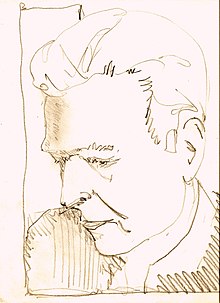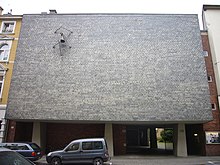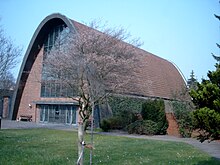Emil Steffann
Emil Steffann , frequent spelling: Emil Steffan , (born January 30, 1899 in Gadderbaum , today Bielefeld , † July 23, 1968 in Bonn ) was a German architect who worked primarily in the field of church and monastery architecture .
Life
Emil Steffann was the son of a doctor from v. Bodelschwingh Foundation Bethel . His ancestors were Huguenots . After high school and military service in 1917/1918 as an aerial scout in the First World War , he attended Hans Perathoner's sculpting classes at the Bielefeld School of Crafts and Applied Arts and the Berlin School of Applied Arts until 1921 . From 1921 to 1928 varied autodidactic studies followed in architecture offices and on construction sites, as well as in the building trade school in Lübeck (Prof. Münch). There he met Walter Gropius and built his first house.
In 1926 Steffann traveled to Assisi . Deeply impressed by Assisi and Saint Francis of Assisi , he became a Catholic. Attracted by the questions of the renewing liturgy and church building, he visited the Corpus Christi Church in Aachen in 1931 (architect Rudolf Schwarz with Hans Schwippert ). Steffann became a member of the Catholic youth movement Quickborn , which met at Rothenfels Castle. There he met Romano Guardini and others who were committed to a renewal of the liturgy and church building. Rudolf Schwarz entrusted him with the construction management of his house in Berlin designed for Guardini, and together they took part in the St. Anna church building competition in Berlin-Lichterfelde.
In Lübeck, Steffann designed underground and house churches for Catholics oppressed by National Socialism (including in Schlutup ) and dealt with small building projects in this Catholic diaspora .
In 1941, during the Second World War , Rudolf Schwarz took over regional planning in the German-occupied Lorraine . In addition to Rudolf Steinbach , his planning staff also included Emil Steffann. Steffann dealt with the reconstruction of war-torn villages. In Boust he built a farm workers' house on the old Roman road from the rubble of the war and created a new village center with his community barn. He summarized his conception of building in 1950 in his article Reconstruction from rubble in the architecture magazine Baumeister . With the help of the self-supporting roof construction, which he had patented after the war, Steffann built a column-free hall that was accessed via a large barn door, which meant a church for him and became a model. He developed ideas about building in accordance with the meaning, which for him required building that was appropriate to the material, construction and location, and wrote the Building Guide for Lorraine. In 1944 Steffann was interned in France with his wife and daughter; In 1946 he returned to Lübeck.
As a member of the Monument Council, he campaigned for the preservation of the reconstruction of the war-torn old town, which he also wanted to preserve through an appropriate traffic plan. In 1947 Rudolf Schwarz brought him to Cologne, where Steffann was in charge of the settlement agency of the Archdiocese of Cologne until 1949 . In 1949, Steffann and his family moved into a small prefabricated wooden house (architect Alfons Leitl ) in Mehlem . This house became his living and workshop until his death in 1968. During this time he built numerous churches, monasteries and social buildings with his construction studio. Important employees were Siegfried Östreicher , Nikolaus Rosiny , Paul Georg Hopmann , Heinz Bienefeld and Gisberth Hülsmann .
Steffann's last work was the parish church of St. Remaclus in Cochem -Cond. Two months after the consecration of this church, he died in July 1968 of the consequences of a car accident.
Honors
For his exemplary work in church construction, Steffann was awarded an honorary doctorate from the Technical University of Darmstadt in 1964 , the State Prize for Architecture of the State of North Rhine-Westphalia and in 1965 the Great Federal Cross of Merit.
Quote
“The possibilities for new designs within a centuries-old tradition are limited. You are decided in the very slow growth of the idea. which is the basis of tradition. Artistic idiosyncrasies therefore find no breeding ground in the long run unless they bring to light the possibilities dormant in the idea itself. "
Reception (selection)
- In 1969 the Christian Art Papers dedicated an issue to Emil Steffann
- In 1979 the building world remembered Emil Steffann
- In 1980 the Kunsthalle Bielfeld showed the Emil Steffann exhibition in the studio gallery (curated by Gisberth Hülsmann with Manfred Sundermann in collaboration with Ulrich Weisner and Herbert Muck )
- In 1981, the Academy of the Chamber of Architects in North Rhine-Westphalia opened the touring exhibition, Two Rhenish Builders of the XXth Century, curated by Manfred Sundermann at the Düsseldorf Art Academy . Century Rudolf Schwarz and Emil Steffann with the symposium on the return of architecture to philosophy .
- The Archives d'architecture modern , AMA Brussels, presented his work in No. 21-1981.
- The 1992 Venice Architecture Biennale Sacred Architecture was dedicated to the work of the construction atelier Emil Steffann.
- Conradt Lienhardt published the monograph Emil Steffann (1899–1968) work / theory / effect in 1999 for the exhibition at the University of Artistic and Industrial Design Linz and in the Franz Wärme Haus Münster . ISBN 3-7954-1227-7
- In 1999 Susanne Grexa published her doctoral thesis The Architect Emil Steffann 1899–1968. The renunciation of originality as a program. (Microfiche)
- In 2009, the Italian architect and building historian Tino Grisi published his essay Action is Everything, Form is Nothing. The transformation of space: Romano Guardini and Emil Steffann on the 40th year of their death. (German / Italian) and in 2014 his doctoral thesis “Can we still build churches?” Emil Steffann and his studio. ISBN 978-3-7954-2872-3
- In 2017, the Chair for Architectural History at RWTH Aachen University is holding the seminar "Built Simplicity - On the Work of Architect Emil Steffann (1899–1968)" "in preparation for an exhibition on Emil Steffann
Characteristic features of his work
- a closed church area made of walls and courtyards that protect against the hustle and bustle of the street
- a courtyard in front of the house of worship for collection (comparable to early Christian churches)
- Lateral, non-central access to the church via a sequence of rooms made up of courtyards, paths and side, low extensions
- massive walls made of rubble, stone (buttresses and round arches, mass and opening)
- open roof trusses
- Well-tried masonry and carpentry techniques: walls made of broken stone or bricks left rough
- visible roof structures
- simple structures, styles and forms
- graduated light.
Work (selection)
- 1932: Design of the Corpus Christi procession in Lübeck
- 1937: Design for an underground air raid shelter
- 1941–1944: Reconstruction of the village of Boust in Eastern Lorraine in the Rudolf Schwarz planning team
- 1950–1952: Franciscan monastery and church of the Immaculate Heart of Mary in Cologne
- 1952: St. Bonifatius in Lübeck
- 1953: St. Konrad in Duisburg -Fahrn
- 1953–1954: Reconstruction of St. Bonifatius (Dortmund)
- 1955: St. Laurentius in Munich
- 1955–1956: St. Mary's Assumption in Alfter-Oedekoven
- 1956: St. Konrad in Marl (today used as a columbarium )
- 1957: St. Elisabeth in Leverkusen-Opladen
- 1957–1963: Heilig Geist Hospital in Cologne-Longerich (in cooperation with Nikolaus Rosiny )
- 1957–1959: St. Maria in den Benden in Düsseldorf-Wersten (in cooperation with Nikolaus Rosiny)
- 1958: Sacred Heart Church in Essen-Altenessen
- 1958–1959: St. Bonifatius in Krefeld -Stahldorf
- 1959–1963: Parish center St. Hedwig in Bayreuth
- 1959: Reconstruction of the St. Elisabeth church in Essen (in cooperation with Nikolaus Rosiny)
- 1960: St. Helena in Bonn (today the intersection at St. Helena ; in cooperation with Nikolaus Rosiny)
- 1960: St. Augustinus in Düsseldorf-Eller (in cooperation with Nikolaus Rosiny)
- 1960: St. Johannes in Dorsten
- 1960–1961: St. Bonifatius in Essen- Huttrop
- 1960–1961: cath. St. Klemens Church in Duisburg-Kaßlerfeld
- 1961: Parish Church of St. Johannes Baptist in Herzogenrath - Merkstein
- 1961: St. Laurentius in Cologne-Lindenthal (changed)
- 1961–1963: St. Hildegard in Bad Godesberg - Rüngsdorf (with sacristy, sexton's apartment and rectory; under monument protection)
- 1961–1964: Marienau Charterhouse (with Gisberth M. Hülsmann)
- 1964–1967: St. Remaclus in Cochem (with Heinz Bienefeld )
- 1965–1967: St. Matthias Church and Franciscan Monastery in Euskirchen (with Heinz Bienefeld and Gisberth M. Hülsmann)
- 1965–1967: St. Walburga in Porta Westfalica
- 1966–1967: St. Hedwig in Cologne-Höhenhaus (with Gisberth M. Hülsmann)
- 1967–1969: Redesign of the parish church of St. Martin in Dornbirn
- before 1968: St. Ursula in Dorsten
Several churches designed by Emil Steffann have since been torn down or profaned and rededicated.
Web links
- Literature by and about Emil Steffann in the catalog of the German National Library
- Article Emil Steffann 1899–1968 from Werk, Bauen + Wohnen , Issue 10, 1981
- Emil Steffann on the homepage of the North Rhine-Westphalian Chamber of Architects
- Works by Emil Steffann along the Strasse der Moderne
Individual evidence
- ^ Günter Rombold: The architect Emil Steffann 1899 - 1968 . In: Christian Art Association of the Diocese of Linz (Hrsg.): Christliche Kunstblätter . Linz June 1969, p. 49 .
- ↑ Nikolaus Rosiny: In memory of Emil Steffann . In: Ulrich Conrads (Ed.): Bauwelt . 59th year, no. 34 . Ullstein GmbH, Berlin, August 19, 1968, p. 1052 .
- ↑ Gerhild Krebs: Emil Steffann. (PDF) In: From: Places of cross-border memory - traces of the networking of the Saar-Lor-Lux area in the 19th and 20th centuries. Lieux de la mémoire transfrontalière - Traces et réseaux dans l'espace Sarre-Lor-Lux aux 19e et 20e siècles, Saarbrücken 2002, 3rd, technically revised edition 2009. Published on CD-ROM and on the Internet at www.memotransfront.uni- saarland.de. Rainer Hudemann with the assistance of Marcus Hahn, Gerhild Krebs and Johannes Großmann, 2002, accessed on March 17, 2017 (German, French).
- ^ Emil Steffann: Reconstruction from rubble. Set out in an old village in Lorraine (1943/44) . In: Dr. Rudolf Pfister with the participation of the Association of German Architects BDA (Ed.): Baumeister . Volume 47, issue 8. Hermann Rinn - Georg DWCallwey, Munich August 1, 1950, p. 489-497 .
- ^ Gisberth Hülsmann: Emil Steffann 1899–1968, Emil Steffann's sketches for the destroyed town center of Bust. Werk, Bauen + Wohnen, 1981, accessed on July 15, 2017 .
- ↑ Gisberth Hülsmann: The Notscheune in Lorraine Boust. A mission statement . In: Conrad Lienhardt, Art Department of the Diocese of Linz (Hrsg.): Series Kirchenbau . 2: Emil Steffann (1899–1968). Work.Theory.Effect. Schnell & Steiner, Regensburg 1999, ISBN 3-7954-1227-7 , pp. 41-48 .
- ↑ Emil Steffann: Building Guide for Lorraine. In: arch + 72. arch +, December 1, 1983, accessed February 17, 2020 .
- ↑ Emil Steffann: Preservation out of awe . In: Ulrich Conrads and Peter Neitzke (eds.): The cities open to the sky, speeches and reflections on the reconstruction of what was lost and the return of the new building in 1948/49 . Bauwelt Foundations, No. 125 . Birkhäuser, Basel, Boston, Berlin 2003, ISBN 3-7643-6903-5 , pp. 180-185 .
- ^ Emil Steffann: Saved old town and modern traffic - a demonstration using the example of Lübeck. Die Zeit, March 6, 1947, accessed on March 19, 2018 .
- ↑ Michael Werling: Emil Steffann or the discreet charm of the 1950s . In: Landschaftsverband Rheinland, LWL Office for Monument Preservation in the Rhineland (ed.): Monument Preservation in the Rhineland . Volume 32, 4th - 4th quarter of 2015. Klartext, Essen 2015, p. 175-184 .
- ↑ Manfred Sundermann: Wood and stone will teach you ... School of uninhibited building: Emil Steffann (1899–1968) employee, student . In: Conrad Lienhardt, Kunstreferat Linz (Hrsg.): Series Kirchenbau . tape 2 . Schnell & Steiner, Regensburg 1999, ISBN 3-7954-1227-7 , pp. 65-92 .
- ↑ Parish Church of Saint Remaclus. In: arch INFORM ; accessed on April 28, 2019.
- ↑ Emil Steffann: Reflection . In: Alfons Leitl (Hrsg.): Baukunst und Werkform . No. 3 . Verlag Nürnberger Presse, 1957.
- ^ Bishop Hermann Volk, Nikolaus Rosiny, Günter Rombold, Alfons Leitl, Heinrich Bartmann, Heinrich Kahlefeld, Hugo Kükelhaus, Gisberth Hülsmann: The architect Emil Steffann 1899 - 1968 . In: Christian Art Association of the Diocese of Linz (Hrsg.): Christliche Kunstblätter . No. 3 . Linz June 1969, p. 49-75 .
- ↑ Ulrich Conrads, Herbert Muck, Gisberth Hülsmann, Manfred Sundermann: Contemporary - Untimely . In: Bauwelt . No. 19 . Berlin May 18, 1979, p. 766-787 .
- ↑ Manfred Sack: Complete simplicity. Die Zeit, December 5, 1980, accessed on May 13, 2019 .
- ↑ Caoline Helmstein: Built simplicity - to the work of the architect Emil Steffann (1899-1968). RWTH Aachen, Chair of Architectural History, accessed on April 28, 2017 .
- ^ Emil Steffann: A diaspora church in the vault building . In: Alfons Leitl (Hrsg.): Baukunst und Werkform . No. 1 . Frankfurter Hefte, Frankfurt am Main 1952, p. 17 .
- ↑ http://www.derwesten.de/staedte/duisburg/nord/katholische-kirche-trennt-sich-von-gotteshaus-in-duisburg-fahrn-id6734717.html
- ^ Emil Steffann: Draft for the reconstruction of the parish church St. Bonifatius in Dortmund . In: Alfons Leil (Hrsg.): Baukunst und Werkform . No. 1 . Frankfurter Hefte, Frankfurt 1952, pp. 16 .
- ^ Emil Steffann with Siegfried Östreicher: Catholic Church St. Laurentius Munich . In: Dr. Rudolf Pfister (Ed.): Builder . 53rd year, no. 12 . Georg DW Callwey, Munich 1956, p. 856-861 .
- ↑ church site (diocese of Münster)
- ↑ Homepage St. Franziskus, Marl ( page no longer available , search in web archives ) Info: The link was automatically marked as defective. Please check the link according to the instructions and then remove this notice.
- ↑ Archive link ( Memento of the original from February 1, 2014 in the Internet Archive ) Info: The archive link was inserted automatically and has not yet been checked. Please check the original and archive link according to the instructions and then remove this notice.
- ↑ http://www.aknw.de/aktuell/architekten-in-nrw/retrospektiven/detailansicht/artikel/nikolaus-rosiny-1926-2011-dem-gemeinwohl-verpfliziert/
- ↑ Archive link ( Memento of the original from March 23, 2014 in the Internet Archive ) Info: The archive link was inserted automatically and has not yet been checked. Please check the original and archive link according to the instructions and then remove this notice.
- ↑ a b c List of sacred buildings in Essen
- ↑ Archive link ( Memento of the original from February 1, 2014 in the Internet Archive ) Info: The archive link was inserted automatically and has not yet been checked. Please check the original and archive link according to the instructions and then remove this notice.
- ↑ http://geodaten.bayern.de/denkmal_static_data/externe_denkmalliste/pdf/denkmalliste_merge_462000.pdf
- ↑ http://gemeinden.erzbistum-koeln.de/pfaränengemeinschaft_eller_lierenfeld/wir_fuer_sie/Pfarrkirchen/sankt_augustinus.html ( Memento from March 23, 2014 in the Internet Archive )
- ↑ Archive link ( Memento of the original from May 29, 2010 in the Internet Archive ) Info: The archive link was inserted automatically and has not yet been checked. Please check the original and archive link according to the instructions and then remove this notice.
- ↑ Kulturstadt Köln ( page no longer available , search in web archives ) Info: The link was automatically marked as defective. Please check the link according to the instructions and then remove this notice.
- ↑ Der Baumeister , born 1963, No. 8
- ^ Stefan Heinz: Cochem-Cond - St. Remaclus. In: Strasse der Moderne - Churches in Germany. German Liturgical Institute, accessed on May 17, 2019 .
- ^ Community of St. Walburga, Porta Westfalica
- ↑ Wolfgang Pehnt : Church death. Germany is razing its churches . In: Frankfurter Allgemeine Zeitung of August 30, 2005, p. 35.
| personal data | |
|---|---|
| SURNAME | Steffann, Emil |
| ALTERNATIVE NAMES | Steffan, Emil |
| BRIEF DESCRIPTION | German architect |
| DATE OF BIRTH | January 30, 1899 |
| PLACE OF BIRTH | Bethel |
| DATE OF DEATH | July 23, 1968 |
| Place of death | Bonn |











